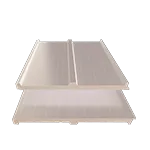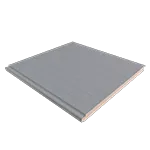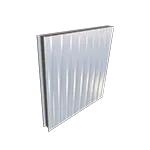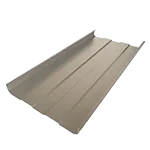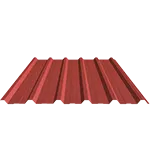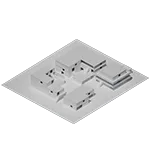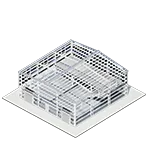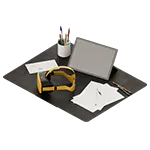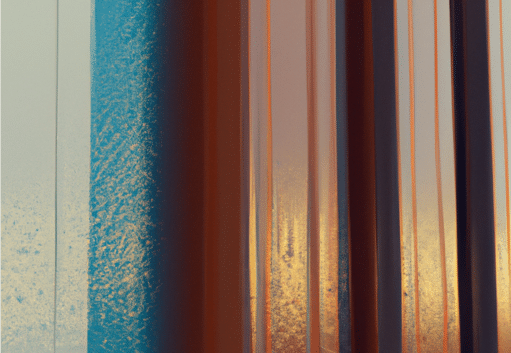Coatings for Insulated Panels
Insulated panels are made of galvanized steel with a pre-lacquered coating, i.e. with a layer that allows a better performance over time in the face of environmental agents such as UV rays due to exposure to the sun; extreme temperature changes from cold to extreme heat; toxic or corrosive environments, either due to proximity to the sea or gases emitted in certain manufacturing industries.
The objective is to protect against external agents and prevent corrosion on the outer and inner layers of the panels. This guarantees durability and optimal performance conditions of the product.
The proper selection of the protective coating on the insulated panels is what allows them to achieve a guarantee in terms of the durability of the product and maintenance of the color for many years.
Most manufacturers purchase galvanized steel sheets with protective treatments and finishes from virtually only two global manufacturers: Arcelor Mittal and Tata Steel. Each has its own patents for finishing and protection for different environmental exposures. That is why knowing and selecting the ideal product for the conditions of our construction projects will allow us to obtain the optimum results desired for each building.
In order to have a basic criterion of how to select the finishes, in this article we will review the most common types of coatings in the manufacture of insulated panels, with special emphasis on the organic type, which is where the main differentiation and performance of the product occurs. We will see a little about their composition, thicknesses, and areas of location with respect to corrosive agents.
Protection Coatings
A steel sheet without any type of protection tends to deteriorate rapidly in the face of external environmental agents. This is why all steel manufacturers must develop protective coatings to ensure the durability of the product.
For this purpose, the most common in the market is a combination of two types of coatings: metallic and organic.
Metallic coatings are those that protect the steel from possible damage and deterioration, extending its useful life. But, with a combination of organic protective coatings, an additional layer is obtained that includes the different colors that can be applied to the insulating panel as protection against corrosive agents, as well as a barrier against impacts and scratches.
Metallic Protective Coatings
The metallic coating is usually done by means of a galvanizing process. This can be done by two different methods: by electrolysis or by hot-dip galvanizing. Each of them will be applied depending on the resistances and processes to be applied to the base material (steel).
In this process, the main component present is zinc, because it provides the steel with properties of resistance to corrosion. In some cases, pure zinc can be applied, or combined with other materials such as nickel, aluminum, etc.
Organic Protective Coatings
The application of organic coatings on the steel sheets used for insulated panel manufacturing is the perfect complement to exceptional protection and is a guarantee of a premium aesthetic level with guaranteed durability over the years.
The 5 most common types of organic coatings for insulated panels are:
Polyester
It is a high-performance finish that forms a protective layer against scratches and shocks. It usually has an application thickness of 25 to 30 microns. Although it is a finish that does not have very good resistance to UV radiation or to the corrosive action of the environment, it is used as a very common basic layer of protection in projects that are not in extreme conditions.
PVDF (ArcelorMittal)
PVDF or vinyldene fluoride is a high-performance coating system widely used as a finish and coating on metal sheets. It is a plastic-type material with a nominal coating thickness of 35 microns.
Its main characteristic is its good performance in chemical environments. It has very good mechanical resistance and does not suffer deformations as a result of the application of weight loads.
It is very stable against temperature variations, and in fact has a working range from -30 degrees Celsius to + 150 degrees Celsius (-22 F to 302 F). It offers very good resistance to ultraviolet rays, aging, radiation, and atmospheric agents.
PVDF guarantees excellent resistance to corrosion and abrasion from highly aggressive chemicals. It is inert to most inorganic acids and bases, aromatic hydrocarbons, alcohols, and halogenated solvents. It offers good chemical and climatic resistance.
It has a self-extinguishing behavior, and no specific additives are required, as it is a halogen compound. Furthermore, it does not absorb humidity.
Therefore, we can conclude that PVDF is a product with excellent adhesion to metal sheets, provides good protection against abrasion, as well as very good resistance to chalking and fading. This makes it an ideal product for non-extreme climatic conditions and UV rays.
HDX Granite (ArcelorMittal)
HDX Granite is manufactured to be a highly durable and resistant finish. So that its colors last and remain unalterable in spite of being exposed to cold weather or in the warmest and sunniest climates.
It is a paint system of 55 microns thick, which allows excellent performance, durability and resistance to corrosion up to RC5, the highest in its category. At the same time, it has a UV resistance up to RUV4, the most rigorous classification in laboratory tests.
Due to its chemical characteristics, it is suitable for use between 300 m and 1 km (984 ft. and 0.6 mi.) from the sea. This provides 15-year durability assurance, high resistance to marine climates, and harsh industrial environments.
It is a product designed to be able to withstand severe climatic conditions, so it can be used in very sunny regions with intense UV radiation such as certain regions of Africa, the Middle East or the Caribbean, where it is also required that the colors remain unaltered over the years.
HPS200 (Tata Steel)
HPS 200 is a maximum-performance finish, designed to withstand the most extreme conditions and very aggressive environments. It provides durability and resistance far superior to what we have been discussing in this article. It has a coating thickness of 200 microns.
It exceeds the requirements of the UV standard, with a RUV4 rating, and similarly meets the anti-corrosion requirements of RC5. This translates into color and gloss retention, as well as excellent corrosion resistance, exceeding the most demanding standards.
It is a finish that can be used in the most demanding conditions such as swimming pools, sewage treatment plants, power plants or composting plants. A sheet with this finish can be installed on buildings located on the coast.
If necessary, it is a product that can be supplied with a double-sided protection option, which also provides a resistant layer on the underside of the steel substrate.
This coating is aimed at the building segment where longevity and durability are essential.
PET coating
PET or Polyethylene Terephthalate, is a polyester widely used in environments that are in contact with food or products that must be easy to clean, as well as maintain maximum hygiene conditions. It usually has a thickness between 100 and 200 microns.
We can say that PET is one of the most produced plastics in the world. It is widely used in the manufacture of packaging, it is recyclable, very resistant, and at a very accessible cost.
PET is a product that is widely used in the food, pharmaceutical, cosmetic, and cleaning industries. It has good resistance to scratches and scrapes. Its application is usually inside cold rooms or special rooms.
It is a very lightweight, chemical-resistant, and thermally non-deformable material. It is also a strong barrier against CO2, and it performs well against moisture and oxygen. This coating is highly resistant to wear and bending and it has excellent mechanical properties. It is important to mention that it is 100% recyclable and allows certain colorants.
Most of the cold rooms that require a high standard and hygienic environment are usually built with PET finish coating. It is a finish that resists very well the application of intense cleaning products and prevents its molecular structure from degrading. The most common presentation is in white color.
As a summary of the type of protective coatings
Insulated panels with steel faces are highly resistant and durable products, but they usually require protection against corrosive or abrasive environmental agents. For this purpose, two types of coatings are usually used: metallic and organic coatings. The metallic ones are based on zinc, and the organic ones are based on additional protections and color pigmentation as a final finish.
The five organic finishes discussed in this article tend to be the most common products in the insulating panel industry. Starting with polyester finish which is the most basic, but with good performance and an application thickness of 25 microns. Continuing with the PVDF with 35 microns thickness, where its characteristics and performance are for more demanding environments.
If the building requires durability under more extreme conditions, we should consider using a Granite HDX coating, with manufacturer’s warranties from 15 years and a thickness of 55 microns, or a high-end finish such as HPS200, with 200 microns of application which exceeds the highest requirements against UV rays and corrosive agents.
Finally, we have the PET finish which is widely used in the construction of cold rooms or special processes such as refrigeration, the food industry, and the pharmaceutical industry, among other places where hygiene and easy cleaning are important in the production process.
With these simple explanations, you can get an idea of the type of finish or coating that you can request from your insulation panel supplier, according to the specific and external characteristics of the construction project you are going to carry out.
